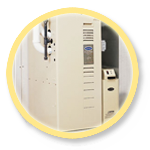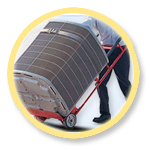FREE In-Home Estimate
@@DisplayNumber
@@Offer
-
Right-size your unit
Make sure the new unit you put into your home is the right size for your home today. Top contractors will complete an electronic load calculation estimate to determine the exact type of heat and air conditioning system for your home rather than just replacing with the same size unit you currently have. These calculations take into consideration things such as the size of your home, which direction it faces, the number and size of windows, insulation and more. This load calculation is especially important if you have added or lost insulation or changed features of your home such as adding rooms. -
Use current refrigerant technology
Some contractors may pull units from existing stocks that were manufactured prior to 2010 or in other markets that do not adhere to U.S. standards. These older units use R-22 refrigerant. While this type of refrigerant met industry standards in the past, it is not up to par with the new industry standard R410A/ Puron Refrigerant. This new refrigerant takes the SEER (Seasonal Energy Efficiency Rating) from 13 to 22 driving up to 7% efficiency improvement and increasing your comfort. Statistics show that this refrigerant has lower warranty service rates, lower compressor failure rates and is a non-ozone depleting HFC (hydro fluorocarbon) refrigerant. -
Understand the type of filtration system
The EPA (Environmental Protection Agency) estimates that each day a person breathes in two teaspoons of pollutants. The correct filtration system in your heat and air conditioning system can help minimize how much of that comes into your home. These pollutants can include things such as pollen, bacteria, plant spores, atmospheric and household dust and more. Adding electronic air cleaners as part of you new system can filter out up to 95% of the particulates that pass through your system. -
Know your Energy Star "U-value"
 The Energy Star program established by the U.S. Government Environmental Protection Agency (EPA) in 1962 provides energy efficiency ratings on products with the goal of saving you money and protecting our environment. Energy Star rated heating and air conditioning products, properly sized and installed, can save you up to 20% on your annual energy bills. All products that carry the Energy Star rating have met very strict energy efficiency guidelines as established by the EPA. Make sure you see that registered Energy Star trademark as units labeled “Energy Efficient” may not offer the same level of efficiencies.
The Energy Star program established by the U.S. Government Environmental Protection Agency (EPA) in 1962 provides energy efficiency ratings on products with the goal of saving you money and protecting our environment. Energy Star rated heating and air conditioning products, properly sized and installed, can save you up to 20% on your annual energy bills. All products that carry the Energy Star rating have met very strict energy efficiency guidelines as established by the EPA. Make sure you see that registered Energy Star trademark as units labeled “Energy Efficient” may not offer the same level of efficiencies. -
Know your installation contractor
 Is your contractor licensed and bonded? Does your contractor have adequate insurance? What warranties do they provide for both materials and labor? Does the contractor obtain the proper permits and follow all local and regional codes and regulations? How reliable is the contractor? What work have they done in your area? Be sure to ask these questions before you hire!
Is your contractor licensed and bonded? Does your contractor have adequate insurance? What warranties do they provide for both materials and labor? Does the contractor obtain the proper permits and follow all local and regional codes and regulations? How reliable is the contractor? What work have they done in your area? Be sure to ask these questions before you hire! -
How are your ducts?
The air that is pumped out of your heat and air conditioning unit flows through ducts. How efficiently that flow moves has a large impact on your costs and the performance and life of your unit. Several factors can impact the air flow including design, system size and cleanliness of the ducts. Does your contractor discuss this with you during the sales presentation and make recommendations? -
Insulate to mitigate
If you are going to the expense of replacing a heat and air conditioning unit, you want to make that investment as effective as possible. This means the hot or cold air flowing into your home needs to stay in. If your insulation is inadequate that may not be the case. A good contractor will discuss this with you and make recommendations to insure you have the right level of insulation to optimize the performance of your new system. This will insure that there is no unnecessary energy loss and that monthly expenses are kept to a minimum. This is especially important if you have an older home, if it seems your furnace or air conditioning seems to run constantly or if your energy bills seem high. Does your contractor discuss the installation “R” value and what is appropriate for your region of the country. Does the contractor discuss the type of insulation needed in different areas of the home such as the attic or walls? -
Know your installation contractor
One of the most important elements of your new system is the service you receive after the installation is complete. Does your contractor offer a standard warranty? What does that include: product, labor, parts? For what length of time does the warranty cover? Is there an extended warranty? What does that include? For how long? What does it cost? How are service calls requested? Is there a cost? Will the company be around for the next 10 years to service the unit they install? -
Fit the unit to your home and local energy resources
 Depending on where you live, you have a variety of choices on the type of heating and air conditioning unit you install in your home. Heat pumps tend to be used in southern locations while furnaces or oil burning heating units proliferate in the Northeast. Some systems are considered “dual fuel” using more than one type of fuel. Package systems provide both cooling and heating from the same system. Be sure your contractor discusses this with you and helps you select the most appropriate unit to save you money, make your home comfortable and be environmentally friendly.
Depending on where you live, you have a variety of choices on the type of heating and air conditioning unit you install in your home. Heat pumps tend to be used in southern locations while furnaces or oil burning heating units proliferate in the Northeast. Some systems are considered “dual fuel” using more than one type of fuel. Package systems provide both cooling and heating from the same system. Be sure your contractor discusses this with you and helps you select the most appropriate unit to save you money, make your home comfortable and be environmentally friendly. -
Price isn't everything

The natural inclination is to find the lowest price. While price should be a consideration, the most important part of the decision should be value and return on investment. Will the contractor charge you a fair price and one that covers the cost of quality installation? Does the unit match your comfort needs and home? In the long run a lower price unit might actually cost you more. Should you invest in a full replacement of both indoor and outdoor equipment? While only replacing one element of your unit may seem like the right decision, your efficiency gains may be lost combined with the older equipment. Will purchasing additional equipment provide value over the long term, for example programmable thermostats, humidifiers or electronic air cleaners?
At Sears Home Services, we want you to find the Heat and Air Conditioning System contractor that is right for you. We believe that providing you all the resources and information to make an informed decision is right for you and for us. We are confident that once you have this information you will know that when you trust Sears Home Services to complete your work, you will receive all the help you need through the process from the initial free sales consultation to the installation of your new Heat and Air Conditioning System and well beyond. We also provide a one stop resource for turnkey completion of your project including permitting, material and professional project management. Our project managers work with you every step of the way to insure the job is completed correctly and professionally. No need to worry about schedules and timelines, they have you covered. And when the installation is complete, you will know that Sears will be around to service and warranty the work. We’ve been serving customers like you for 125 years!






